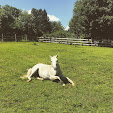One of the biggest challenges, after figuring out a mental picture of a character, is translating that onto paper.
Helen always had thick, curly brown hair and an expressive face. Her dramatic eye rolls and stubborn questioning were accented by big, round eyes and well-shaped (but not thin) eyebrows. When I tweaked her face shape a bit, I turned to a website on hairstyles for different face shapes. For more complicated expressions/poses I use stock photos, but my basic picture of her has been pretty consistent for the past six years.
Perhaps because he's a quieter character, Reuben did not have many distinguishing features for a while. When I started writing the book, I thought of him as a tall, but otherwise unremarkable middle-aged white guy. A few extra pounds, some chemo-induced hair loss later on, but nothing memorable.
When I tried drawing his face, though, I ended up
modeling him after a younger Paul Sorvino. I realized that a round face and somewhat prominent nose helped make Reuben look more similar to Helen, but dissimilar enough that she could still share some of her mother's features.
Donna Bianci (the labor and delivery nurse who delivered Helen and later becomes an oncology nurse) was also a challenge. My mental
picture of her is a pediatric nurse from Children's Hospital Boston in
Waltham. But in terms of personality, she has elements from three
different nurses I've worked with (all of them were named Donna). Since she reminds me of four very real people, I wanted to make her visual design from scratch. It's still in progress.
Katie and Chloe Green (two sisters who appear much later in the book), like Reuben, seemed to come alive in the drawing process. They were written as short, blonde, and petite, but their faces were unclear. Looking at my current sketches of both of them, I was most satisfied with how much they resembled each other, and with how their expressions came out. Sometimes that can be the hardest thing to nail in a picture.
Pictures below.
